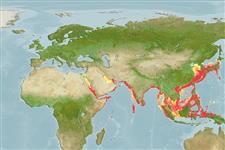分类 / Names
俗名 | 同种异名 | Catalog of Fishes(属, 种) | ITIS | CoL | WoRMS | Cloffa
Environment: milieu / climate zone / depth range / distribution range
生态学
海洋; 淡水; 半咸淡水 居于水底的; 海洋洄游的; 深度上下限 ? - 800 m (Ref. 100719), usually ? - 300 m (Ref. 9942). 亚热带的; 47°N - 4°S, 30°E - 143°E (Ref. 54598)
Indo-West Pacific: Red Sea, Persian Gulf, west coast of India, and Sri Lanka to Fiji and Tuvalu (Ref. 12596), north to Japan and Korea, south to the Arafura Sea (Ref. 9819) and northern Australia. Migrated to the Mediterranean via the Suez Canal (Ref. 6724).
印度-西太平洋: 红海,波斯湾,印度西岸与斯里兰卡到斐济与吐瓦鲁 (参考文献 12596),北至日本与韩国, 南至阿拉弗拉海 (参考文献 9819) 与澳洲北部。 经由苏伊士运河回游到地中海了。 (参考文献 6724)
大小 / 重量 / 年龄
Maturity: Lm ? range ? - ? cm
Max length : 220 cm TL 雄鱼/尚未辨别雌雄; (Ref. 559); common length : 80.0 cm TL 雄鱼/尚未辨别雌雄; (Ref. 3397); 最大年龄: 15 年 (Ref. 72462)
背棘 (总数) : 0; 臀棘: 0; 脊椎骨: 145 - 159. Snout long; eye diameter 2-2.5 times in snout length; posterior nostrils much closer to eyes than to anterior nostrils; mouth very large; teeth generally large and conspicuous (Ref. 4832). Head broader, interorbital about 8 times in head; lateral-line pores before anus 44-47; dorsal-fin rays before anus 66-78; vertebrae 145-159 (Ref. 9830).
吻长的; 倍分之一吻长的眼直径 2-2.5; 后鼻孔更靠近眼超过对前鼻孔; 嘴非常大的; 齿通常大而显着的.(参考文献 4832) 头部比较宽的, 眼间骨大约 8 倍头长比率; 侧线孔在肛门前 44-47; 背鳍鳍条在肛门前 66-78; 脊椎骨 145-159.(参考文献 9830)
Occurs from the littoral zone to the upper bathy-benthic region (Ref. 9942, 11230). Inhabits soft bottoms (Ref. 11230), also found in estuaries. Sometimes enters freshwater environment (Ref. 9987). Feeds on small bottom fishes and crustaceans. Captured and cultured for fishery in Japan. Marketed mainly fresh (Ref. 7238). Also used as bait for shark fishing (Ref. 2872). Also caught by bag (dol) nets. Used in Chinese medicine (Ref. 12166).
生存于海滨的区域到上面的 bathy-底栖的区域。 (参考文献 9942,11230) 栖息于软质底部 (参考文献 11230), 也发现于河口。 有时进入淡水的环境。 (参考文献 9987) 吃小的底层鱼类与甲壳动物。 为日本水产业捕获了而且养殖。 生鲜地主要地在市场上销售。 (参考文献 7238) 也对于鲨鱼钓鱼的用来当鱼饵.(参考文献 2872) 也被袋网捕获。 被用于中药材了。 (参考文献 12166)
Life cycle and mating behavior
成熟度 | 繁殖 | 产卵场 | 卵 | 孕卵数 | 仔鱼
印度-西太平洋: 红海,波斯湾,印度西岸与斯里兰卡到斐济与吐瓦鲁 (参考文献 12596),北至日本与韩国, 南至阿拉弗拉海 (参考文献 9819) 与澳洲北部。 经由苏伊士运河回游到地中海了。 (参考文献 6724)
Masuda, H., K. Amaoka, C. Araga, T. Uyeno and T. Yoshino, 1984. The fishes of the Japanese Archipelago. Vol. 1. Tokai University Press, Tokyo, Japan. 437 p. (text). (Ref. 559)
世界自然保护联盟红皮书 (Ref. 130435: Version 2024-2)
人类利用
渔业: 高经济性; 养殖: 商业性; 游钓鱼种: 是的; 诱饵: occasionally
工具
特别资料
下载 XML
网络资源
Estimates based on models
Preferred temperature (Ref.
123201): 11.6 - 23.2, mean 17.4 °C (based on 401 cells).
Phylogenetic diversity index (Ref.
82804): PD
50 = 0.6250 [Uniqueness, from 0.5 = low to 2.0 = high].
Bayesian length-weight: a=0.00427 (0.00162 - 0.01121), b=3.06 (2.84 - 3.28), in cm total length, based on LWR estimates for this (Sub)family-body shape (Ref.
93245).
营养阶层 (Ref.
69278): 4.4 ±0.67 se; based on food items.
Generation time: 5.8 ( na - na) years. Estimated as median ln(3)/K based on 1
growth studies.
回复力 (Ref.
120179): 中等的, 族群倍增时间最少 1.4 - 4.4年 (Tmax=15; K=0.19-0.33; Min Rel Fec=153).
Prior r = 0.57, 95% CL = 0.37 - 0.85, Based on 3 data-limited stock assessments.
Fishing Vulnerability (Ref.
59153): High vulnerability (62 of 100).
Climate Vulnerability (Ref.
125649): Very high vulnerability (85 of 100).
Nutrients (Ref.
124155): Calcium = 30.7 [16.9, 59.0] mg/100g; Iron = 0.831 [0.484, 1.436] mg/100g; Protein = 19.1 [16.9, 21.6] %; Omega3 = 0.339 [0.157, 0.993] g/100g; Selenium = 66.3 [35.3, 123.9] μg/100g; VitaminA = 6.96 [2.12, 22.85] μg/100g; Zinc = 0.412 [0.295, 0.612] mg/100g (wet weight);
